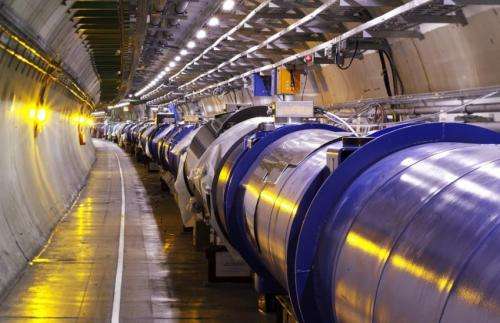April 21, 2016 report
Diphoton bump at LHC leads to generation of hundreds of theoretical papers

(Phys.org)—Last year, two teams working at the LHC reported that they had found proton-to-proton collisions that had led to the creation of more photon pairs (with energies of approximately 750 GeV) than was expected, leading to theories that the evidence might be pointing to a new particle than no one has theorized. This discovery led to a plethora of teams creating papers seeking to be the first to explain this seeming anomaly—so many papers have been submitted to journals for publication that editors have had to pick and choose which to publish. One example is Robert Garisto with Physical Review Letters, who has published an editorial describing the onrush and the decision to publish just four papers in their latest edition, which the editorial team believes is representative of the four main ideas.
In the first paper, Christoffer Petersson with Chalmers University of Technology in Sweden and Riccardo Torre with Institut de Théorie des Phénomènes Physiques in Switzerland, suggest the bump represents the existence of a boson with very weak interactions that is possibly a supersymmetric partner of the still hypothetical fermion called the goldstino.
In the second paper, the trio Yuichiro Nakai, Ryosuke Sato and Kohsaku Tobioka with affiliations to institutions in the U.S., Israel, and Japan suggest that the bump is evidence of a pion-like boson (a particle made of exotic quarks) which is not currently included in the standard model, and which may be associated with a new type of strong force.
In the third paper a small team from China suggests that the bump can be explained by a Higgs-like boson, one that is six times more massive, that couples to new types of fermions. Garisto notes that this idea or ones similar to it are among the most popular explanations by teams submitting papers to explain the bump.
The fourth paper, by a team of researchers from Korea and the U.S., departs dramatically from the other three and suggests that the increase in photon pairs is merely evidence of the destruction of a much larger particle and the pairs are just part of the debris field.
The LHC, it might be noted, is in the middle of restarting after a maintenance period, most in the field expect that one of the above theories or perhaps another one altogether will shown to be the true answer as the collider returns to action and starts to offer more and more evidence via future experiments. It has also been noted that it is also still possible that the bump was merely a fluke, and that all the work done to create the papers will prove to have been wasted effort.
More information: Robert Garisto. Editorial: Theorists React to the CERN 750 GeV Diphoton Data, Physical Review Letters (2016). DOI: 10.1103/PhysRevLett.116.150001
Christoffer Petersson et al. 750 GeV Diphoton Excess from the Goldstino Superpartner, Physical Review Letters (2016). DOI: 10.1103/PhysRevLett.116.151804
Yuichiro Nakai et al. Footprints of New Strong Dynamics via Anomaly and the 750 GeV Diphoton, Physical Review Letters (2016). DOI: 10.1103/PhysRevLett.116.151802
Gang Li et al. Pseudoscalar Decaying Only via Loops as an Explanation for the 750 GeV Diphoton Excess, Physical Review Letters (2016). DOI: 10.1103/PhysRevLett.116.151803
Won Sang Cho et al. 750 GeV Diphoton Excess May Not Imply a 750 GeV Resonance, Physical Review Letters (2016). DOI: 10.1103/PhysRevLett.116.151805
Journal information: Physical Review Letters
© 2016 Phys.org





















